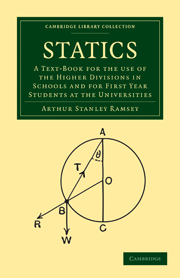 Statics
Statics Published online by Cambridge University Press: 07 September 2010
13·1. So far we have been dealing largely with such mathematical fictions as rigid bodies, weightless rods or inextensible strings, but in the present chapter we propose to bring our investigations into closer touch with reality by showing how to make allowance for the fact that bodies are not rigid but undergo small changes in form when subject to the action of force.
We shall confine our considerations to a few simple cases of isotropic bodies. An isotropic body is such that if a sphere is cut out of the body anywhere it possesses no directional properties of any kind, as distinct from a crystalline body or a body of fibrous structure.
The simplest type of deformation or strain that a body can undergo is a uniform extension, in which all elements of length PQ in a certain direction are altered to elements of length P′Q′ such that the increment in length P′Q′ – P′Q′ is a certain fraction ∈ of the original length, i.e. ∈=(P′Q′ – P′Q′)|PQ. This fraction e is then called the extension.
Regarding a contraction as a negative extension it is clearly possible for a body to be extended in more directions than one. It is obvious, for example, that if a bar is extended longitudinally it will in general contract laterally. We do not propose, however, to analyse the different kinds of strain that are possible but only to deal with some simple cases.
To save this book to your Kindle, first ensure no-reply@cambridge.org is added to your Approved Personal Document E-mail List under your Personal Document Settings on the Manage Your Content and Devices page of your Amazon account. Then enter the ‘name’ part of your Kindle email address below. Find out more about saving to your Kindle.
Note you can select to save to either the @free.kindle.com or @kindle.com variations. ‘@free.kindle.com’ emails are free but can only be saved to your device when it is connected to wi-fi. ‘@kindle.com’ emails can be delivered even when you are not connected to wi-fi, but note that service fees apply.
Find out more about the Kindle Personal Document Service.
To save content items to your account, please confirm that you agree to abide by our usage policies. If this is the first time you use this feature, you will be asked to authorise Cambridge Core to connect with your account. Find out more about saving content to Dropbox.
To save content items to your account, please confirm that you agree to abide by our usage policies. If this is the first time you use this feature, you will be asked to authorise Cambridge Core to connect with your account. Find out more about saving content to Google Drive.